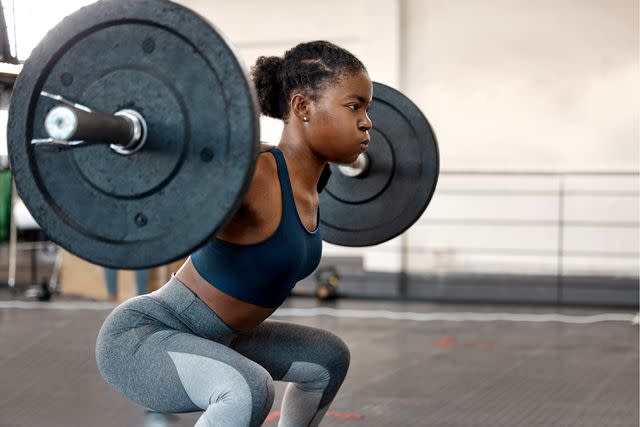Make Your Workout More Meaningful With These 5 Gratitude Tips
Here’s how—and why—you should incorporate a thread of appreciation into your fitness routine.

Getty Images / SHAPE
When you’re in the midst of a killer sweat session, gratitude, which Merriam-Webster defines as “the state of being grateful; thankfulness”—may not be the first word that comes to mind. (More like I can’t wait for this ish to be over!) But it should be.
“It’s easy to be grateful when things are going well,” says Lauren Solomon, a Harlem-based yoga instructor, reiki practitioner, and doula. “During challenges is when the practice of gratitude is all the more important as it shifts your focus from what we may perceive as problematic to those areas that are working out well.” Solomon, who engages in a daily gratitude practice, goes on to say that no matter how “small” a challenge— working to hold crow pose for a little bit longer, struggling to eke out an extra rep, or shuffling through that final mile—“we are wise to not take anything for granted.”
Not to mention being thankful literally resets the brain for the better, says Aeva Gaymon-Doomes, M.D., a licensed psychiatrist in private practice in Washington, D.C. Research backs up this brain claim. A study in Translational Psychiatry found that a combo of focused meditation and aerobic exercise helps reduce depressive symptoms. Another study in Personality and Individual Differences revealed a correlation between gratitude and one’s propensity for engaging in healthy activities (think exercise) and having better health outcomes.
“Gratitude and other positive emotions can [also] contribute to enhancing performance through the Broaden and Build theory, coined by Dr. Barb Fredrickson,” adds Stephen Gonzalez, Ph.D., CMPC, Assistant Athletics Director for leadership and mental performance at Dartmouth College. “Essentially, positive emotions such as gratitude, awe, appreciation, and optimism allow for the mind to stop zeroing into a strong feeling of disappointment or frustration and broaden the attention one has to find more effective thoughts and solutions.”
Ready to make your next workout even more meaningful? These expert and science-backed tips offer ways to weave gratitude into your fitness routine and why it’s important.
Know Your Why
Unless you live under a rock, you’ve heard the phrase 'find your why.' This thinking is rooted in understanding your purpose, the underlying cause of what propels you to do something. According to research, those with a greater sense of purpose in life were less likely to experience physical limitations (think weakened grip strength and reduced walking speed) as they aged. Now, imagine applying this thinking to your exercise routine. Knowing why you are heading to the gym every day, whether it’s to curtail physical limitations like in this study or to reduce stress, shore up your strength, or bolster your confidence, may help you appreciate your workouts even more.
Related: Challenging But Attainable Fitness Goals to Work Toward
Appreciate Each Challenge
According to Kira Stokes, a NASM-certified celebrity trainer and creator of the Stoked Method, starting off with a moment of gratitude before you get into your sweat session helps set the tone for the workout. Plus, ending a workout with gratitude allows you to be proud of what your body has accomplished. Her rec: “Before the workout, thank your body for simply showing up, as that’s the hardest part,” says Stokes, who also holds a B.A. in Psychology. Afterward, “take a moment to be grateful for the ability to move and challenge [your] body, as it’s truly a gift, not a guarantee.” Remember: There are folks who wish they could engage in some of the movement patterns you often take for granted.
Guide Your Grit

Getty Images
“Perspective is such an important part of overcoming challenge and adversity,” explains Dr. Gonzalez. “If you can approach the frustration of a tough workout with the question, “Where’s the opportunity?” you can start to allow difficult challenges to grow your toughness and mentality rather than be a victim of your initial thoughts.” While you’re at it, Peloton fitness instructor Jess Sims adds that having a mantra— such as “I get to work out”; “This is a privilege, not a punishment”; “I am doing this because I love my body”; or “I am doing today's best…not yesterday’s, not last week’s, not last year’s”—in these moments may also help to shift your perspective to zero in on gratitude.
Sims also notes that mid-workout gratitude and appreciation take some of the pressure off. “Sometimes I want to go and do a super tough workout and then when I get into it I might feel that my right hamstring is a bit tight, or my quads are sore, or I didn't hydrate enough before and my endurance feels off. Instead of beating myself up over it, gratitude allows me to surrender to how my body is feeling and appreciate whatever it is that I can do instead.” The result: a genuine love and appreciation for your body and its abilities.
Be in the Moment
When working out, we often go through the motions rather than concentrating on the task at hand. But, being more mindful of what you are doing (for example, focusing on the exact muscles it takes to lift that dumbbell through a full range of motion) can help you score even greater results. Sims, who says she works hard to really be present during her workouts, also suggests doing a head-to-toe body scan as you move through each motion, naming three things you're experiencing with each of your senses. Whether it’s feeling your heart pounding as it gets stronger, listening to your life-sustaining breath, or taking in the different movements your body must fulfill to pull off each moment, zoning in on things like this is extremely “grounding in the moment,” says Sims.
Keep a Gratitude Log

Getty Images
Many exercisers keep running logs or weight-lifting diaries as a way to track workouts, see progress, catch patterns, note if they are feeling tired or energized, and set goals. Consider adding a space in those journals to write down what exactly about the workout you are thankful for. Here’s why: “What we focus on grows and expands,” says Solomon, and that includes your workout habits and your health. Need more evidence? Research shows that those who regularly count their blessings in written form not only exercised more but also increased their overall life satisfaction.
You may also want to jot down a note about how nice it was that your workout buddy made time to sweat with you, how they helped you push through a tough circuit, or even how they were your spotter as you attempted a super heavy lift. In fact, go a step further and actually say these things directly to the person. Research shows it can boost your connection and satisfaction.
Related: The 11 Best Guided Journals of 2023, Picked By Mental Health Pros
“Movement is medicine,” says Solomon, and when paired “with the practice of gratitude, [we] have the potential to create positive change in every area of our lives.”
For more Shape news, make sure to sign up for our newsletter!
Read the original article on Shape.

